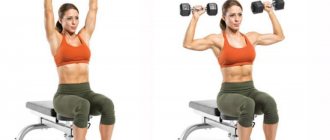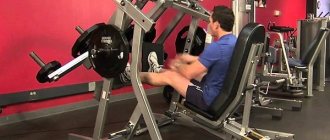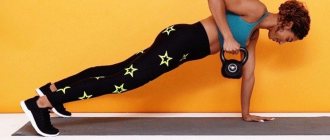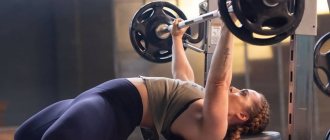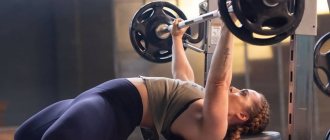Push-ups from the horizontal bar at the top point are an exercise of increased complexity. To perform it, you first need to pull yourself up and take an emphasis on the horizontal bar, placing your body on top. Technically, this movement is part of a forceful exit. This is exactly how it is used. Bodybuilders believe that the exercise is ideal for pumping up the lower chest. But in fact, it involves the triceps and deltoids.
Benefits and disadvantages of exercise
The main advantages of push-ups on the horizontal bar:
- Working on the entire shoulder area, taking into account the stabilizers;
- Training the chest, especially the lower part;
- Receiving a powerful load when working with your own body weight;
- Development of coordination and balance;
- Training for power lifting, lifting and turning over and other exercises.
Disadvantages of push-ups on the horizontal bar from above:
- Increased load on the shoulder joint;
- Requires a high level of physical fitness to fully perform;
- The effectiveness of the exercise directly depends on body weight and the relationship with strength indicators.
Pull-ups are also classified according to technique:
- Vince Gironda's pull-up.
Also called a chest pull. Develops the latissimus dorsi muscles, while having an additional effect on the pectoral muscles. It is usually performed with a medium reverse grip. An important difference from the usual pull-ups in the back arch, which the athlete does at the top point, as if touching the crossbar from below. - Pull-up with clap.
This type is available for advanced athletes with experience in pull-ups. Palm clapping can be done both in front of you and behind your back. This exercise is an excellent way to develop your back, shoulders and arms while training your grip.
You can choose and buy a horizontal bar for your home on our website in the “Pull-up bars and parallel bars” section.
What muscles work
When performing push-ups from a horizontal bar, the muscles of the entire upper body work. The main burden falls on:
- Pectorals (mainly lower part);
- Deltoid (middle and anterior bundles);
- Triceps brachii;
- Forearm muscles;
- Latissimus;
- Press.
Some areas work in a static mode (for example, the abdominals), they stabilize the position of the body.
Push-ups on perpendicular bars [edit]
By doing push-ups on perpendicular bars, you can combine the advantages of parallel bars and a horizontal bar. Give free rein to your imagination in your daily workouts, since you do not have access to standard sports equipment.
Push-ups on perpendicular and parallel bars are very similar, although each of these types has its own characteristics. Just like on the uneven bars, you can change the angle of inclination to put stress on different muscles. To better work your chest, lean forward more, and to better work your triceps and abdominal muscles, keep your body straight. A horizontal bar with perpendicular bars allows you to do this without adding stress to your shoulders. Just make sure you have the strength to complete this variation before you start doing reps.
Execution technique
It is worth moving on to mastering the movement only after the athlete can perform a series of at least 3-4 sets of 5-7 repetitions on the uneven bars, and can also do at least 5 classic pull-ups.
Technique:
- Approach the bar (it is recommended to use a low one), grab it with a grip wider than shoulder level.
- Power up or simply jump to hover over the bar.
- Lower yourself down until your lower chest touches the bar. At the bottom, the triceps should be parallel to each other.
- Pause for 1-2 seconds, then slowly return to the starting position without straightening your elbows completely.
It is important to consider that when lowering down, you must maintain balance. To do this, the legs are placed forward, which leads to twisting of the body and maintaining the desired position.
How to learn to do push-ups from scratch: a ready-made plan
It's okay if you've never done push-ups before or had a long break from fitness and have lost this skill. Anyone can learn to do push-ups, regardless of gender or age!
Of course, you'll need regular practice, but learning how to do push-ups is not as difficult as, say, doing pull-ups.
The most important thing to remember if you want to learn how to do push-ups efficiently and effectively: you must always follow the correct technique.
from the very first repetition of the exercise. Even if you start with simple variations of the exercise, remember to use proper form and technique.
In order to start doing push-ups from scratch, we offer you a step-by-step program for beginners. Thanks to this scheme, everyone can learn push-ups!
A ready-made diagram of how to learn to do push-ups for beginners
In order to learn how to do push-ups, you will need to master 3 levels of push-ups
. You need to exercise daily, you need to perform 3-4 approaches with the maximum number of repetitions in each approach. Perhaps your first attempts will not allow you to do more than 5-10 push-ups, but every day you will progress.
If you feel like you haven't made the progress you want at the end of the week, then continue doing the same push-up modification for another week. It’s better to move to the next difficulty level after you can do 30-40 push-ups without interruption
. Don't forget about the correct push-up technique!
Week 1: Wall push-ups
Wall push-ups are an exercise that everyone can do. These vertical push-ups are a great introductory exercise that will help you master push-ups later on.
Week 2: Knee push-ups
The next level is knee push-ups. Please note that even when doing push-ups from the knees, the body should maintain a straight line, the pelvis should not go up.
Week 3: Push-ups
Once you have mastered knee push-ups, you can move on to bench push-ups. Attention, there is a nuance here. The higher the bench, the easier it will be for you to do push-ups. Therefore, you can change the height of the surface, thereby slowly preparing yourself for push-ups from the floor.
Week 4: Push-ups
After three weeks of regular push-ups, your body will be ready for push-ups. Remember that it is better to do fewer repetitions, but with full amplitude (elbows should bend 90 degrees).
You can continue to progress in push-ups by choosing the option with your feet resting on the bench
. There are also various more complex modifications of the exercises, which will be discussed below.
How many times should you do push-ups: ready-made push-up patterns
We emphasize once again that you should never chase quantity while neglecting quality. In addition, you don't always need to strive for more repetitions. How many times you need to do push-ups depends on your goals.
So, there are several possible situations:
1. If you want to pump up
and increase muscle mass in volume, then move towards increasing weight and complexity. For example, use barbell plates or elevate your feet on a bench. Training scheme: 10-12 repetitions of 3-4 approaches.
2. If you want to lose weight
and get relief, then move towards increasing the number of repetitions. Perform 15-25 repetitions in 5 sets. You can increase the total number of push-ups weekly or move on to more complex modifications.
3. If you want to develop endurance
and functional strength, then also move towards increasing the number of repetitions and choosing more complex modifications of floor push-ups, including plyometrics.
An example of a ready-made push-up scheme for increasing endurance and losing weight:
An example of a ready-made push-up scheme to increase muscle mass:
Scheme of push-ups on the horizontal bar
The standard push-up pattern on the horizontal bar is recommended for mastering the exercise. Suitable for both beginners and advanced athletes.
| A week | 1 | 2 | 3 | 4 | 5 | 6 | 7 | 8 | 9 | 10 |
| Approach 1 | 3 | 4 | 5 | 6 | 7 | 8 | 9 | 10 | 11 | 12 |
| Approach 2 | 4 | 5 | 6 | 7 | 8 | 9 | 10 | 11 | 12 | 13 |
| Approach 3 | 4 | 5 | 6 | 7 | 8 | 9 | 10 | 11 | 12 | 13 |
| Approach 4 | 5 | 6 | 7 | 8 | 9 | 10 | 11 | 12 | 13 | 14 |
| Approach 5 | 5 | 6 | 7 | 8 | 9 | 10 | 11 | 12 | 13 | 15 |
Nuances of weight training
Considering the number of muscles working, a properly designed training program is quite suitable for increasing their mass. Although, of course, not in a week, preparation is necessary first. For a month, every day, consistently perform 3 approaches to failure (but not less than 10 times) of pull-ups with a narrow reverse, straight wide and neutral medium grip. The fourth day is “unloading” (3 series of 10 pull-ups with a shock absorber or while jumping).
Further, according to the same scheme, to increase performance, they continue to work with weight. Bodybuilding professionals and athletes use weight vests or leg weights; at home, you can get by with water bottles tied to your waist, a backpack with barbell weights or dumbbells. The weight is selected so that the last 2-3 times are given with noticeable difficulty, but without failures in technique. Here, too, a “fasting” day is required, when work is done without burden.
Recommendations for implementation in training
This type of push-up is great for street training. The exercise can be combined with other movements, such as parallel bars, to better work the pectoral and shoulder muscles.
Read more about dips →
Basic recommendations:
- First you need to learn how to perform at least 4-5 push-ups with the correct technique;
- After this, you can begin to progress by doing full approaches;
- Proceed only after thoroughly warming up your entire body. It is recommended to perform an additional series of simple exercises to warm up the shoulders;
- Try to do at least 4-5 series in one workout.
Based on the width of the grip and the position of the palms, they are distinguished:
- Narrow straight grip.
Mainly the deltoids, trapezius, serratus anterior, and arm muscles are involved. Of course, the latissimus dorsi and subscapularis muscles are also trained with this exercise, but to a lesser extent than with other types of grips. - Narrow reverse grip.
This type of pull-up is considered the best for working specifically on the biceps. It also works the muscles of the shoulder girdle: deltoids and trapezius. - Medium straight grip.
The most common type of grip, which is recommended for use by beginning athletes. It gives a balanced load to the muscles of the shoulder girdle, as well as the pectoral and back muscles. - Medium reverse grip.
It is mainly used to give a complex load to the latissimus dorsi and biceps muscles at the same time. Less stress on the pectoral muscles. - Wide straight grip.
The only position of the palms with a wide grip is straight. A reverse wide grip is not used because it is physically impossible to do. This type of grip is the most difficult of all presented, since the main emphasis in it falls on the back muscles and partly on the biceps. It is with the help of this type of pull-ups that you can increase the width of your back and achieve the desired V-shaped silhouette. - Neutral or inside grip.
Also called parallel grip. During its execution, the palms are facing each other, and the athlete’s head is under the crossbar. This exercise targets the lower latissimus dorsi, shoulder girdle, and biceps. This grip is considered comfortable in terms of stress on the joints, as the hands are in a more natural position. - Mixed grip.
With this type of grip, the palms look in different directions - away from you and towards you. This type of grip is used mainly only by advanced athletes in order to get more grip on the barbell, for example, when there is a need to do pull-ups with weights (read about the main mistakes when doing pull-ups on the horizontal bar).
Push-up training program
| Level 1 | Incline push-ups | 3 sets of 20 |
| Level 2 | Knee push-ups | 3 sets of 15 |
| Level 3 | Partial push-ups | 3 sets of 15 |
| Level 4 | Classic push-ups (with mid-arm position) | 4 sets of 10 |
| Level 5 | Reverse push-ups | 4 sets of 10 |
| Level 6 | Dips | 4 sets of 8 |
| Level 7 | Diamond push-ups | 4 sets of 7 |
| Level 8 | Uneven-high push-ups with ball support | 4 sets of 7 |
| Level 9 | One-arm push-ups | 4 sets of 4 |
| Level 10 | Handstand push-ups | 3 sets for max. |

